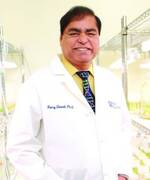
09 Dec COVID-19: Specialized Gum Could Trap Virus, Limiting Spread and Disease Severity
MedicalResearch.com Interview with:

Dr. Daniell
Dr. Henry Daniell Ph.D
W. D. Miller Professor & Director of Translational Research,
Vice Chair, Department of Basic and Translational Sciences,
Editor in Chief, Plant Biotechnology Journal, Oxford, UK
School of Dental Medicine,
University of Pennsylvania,
Philadelphia PA 19104-6030
MedicalResearch.com: What is the background for this study?
Response: ACE2 is a human protein present in human cells, blood and saliva. In COVID-19 patients this protein is inactivated. SARS-CoV-2 virus enters human cells using receptor of this protein. ACE2 chewing gum utilizes two different mechanisms. ACE2 enzyme directly binds to the spike protein on SARS-CoV-2 and traps virus in the chewing gum. In addition, ACE2 enzyme binds to its own receptor on oral epithelial cells, thereby blocks entry of any virus that is not trapped in the chewing gum
MedicalResearch.com: What are the main findings?
Response: ACE2 was tested for trapping virus in the gum as well as blocking virus entry into human cells. Even very small quantity (50 mg) neutralized >95% of SARS-CoV-2 virus in the saliva but each gum weighs two grams. Therefore, chewing gum should protect patients for disease progression due to reduced viral load. Virus not trapped by the gum is further blocked by entering human cells because excess ACE2 enzyme will bind to its own receptor, thereby closing gates for viral entry.
MedicalResearch.com: What should readers take away from your report?
Response: Proteins bioencapsulated in the chewing gum are stable and fully functional for several years when stored at ambient temperature (see links below), thereby making them affordable by elimination of complex manufacturing processes, expensive cold storage, transportation and other costs associated with current vaccines. SARS-CoV-2 replicates in the salivary glands. Therefore, debulking virus in the oral cavity should decrease reinfection of COVID-19 patients, in addition to prevention of transmission. So, ACE chewing gum should provide COVID-19 patients time to build immunity and help reduces disease severity which depends on viral load. Until vaccines are available globally, ACE2 chewing gum could help decrease transmission and disease severity.
MedicalResearch.com: What recommendations do you have for future research as a result of this work?
Response: During the clinical trial, we will find out how long it takes for the virus to replicate in the salivary glands and repopulate saliva (anticipated to be >4 hours). Number of chewing gum used per day will be determined by this study. However, if a patient is in the dental clinic with mouth wide open, even one hour would be adequate to protect others in the clinic exposed to the aerosol particles.
MedicalResearch.com: Is there anything else you would like to add?
Response: Yes, chewing gum has been developed to treat oral pathogens as shown in the link below. In addition, work is in progress with other viral trap proteins to prevent influenza (Flu) virus transmission, where sneezing propels particles for much longer distances than SARS-CoV-2.
No financial conflict to disclose
Citation:
A chewing gum that could reduce SARS-CoV-2 transmission
Debulking SARS-CoV-2 in saliva using angiotensin converting enzyme 2 in chewing gum to decrease oral virus transmission and infection
Daniell, Henry et al.
Molecular Therapy, Volume 0, Issue 0
https://onlinelibrary.wiley.com/doi/full/10.1111/pbi.13643
https://www.sciencedirect.com/science/article/pii/S0142961219308683
[subscribe]
[last-modified]
The information on MedicalResearch.com is provided for educational purposes only, and is in no way intended to diagnose, cure, or treat any medical or other condition. Always seek the advice of your physician or other qualified health and ask your doctor any questions you may have regarding a medical condition. In addition to all other limitations and disclaimers in this agreement, service provider and its third party providers disclaim any liability or loss in connection with the content provided on this website.
Last Updated on December 9, 2021 by Marie Benz MD FAAD
